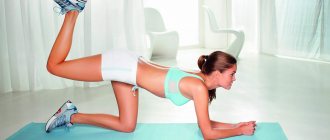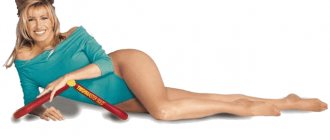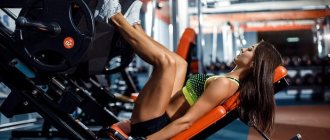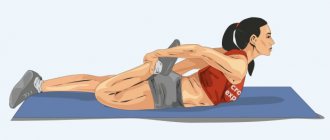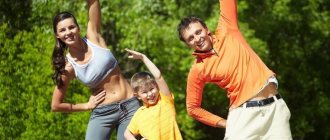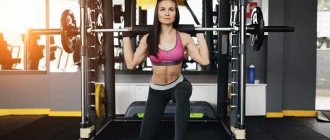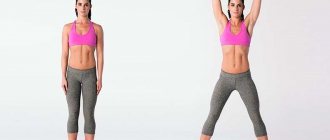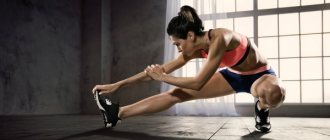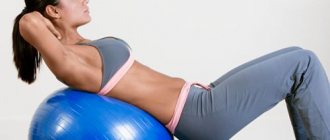To pump up your thighs means to make your legs beautiful and strong. This can be done in different ways. Although pumping up your thighs using proven sets of exercises is much safer and more reliable.
The thigh muscles are one of the large muscle groups located on the lower limbs of a person. Among them there are three subgroups:
- anterior, represented mainly by extensor muscles;
- medial, consisting of the adductor muscles of the thigh;
- posterior ones, which are flexor muscles.
Among the anterior muscles:
- the sartorius muscle, which is the longest muscle on the human body:
- looks like a long narrow ribbon;
- starts from the iliac spine (its top) and ends at the knee, having a complex attachment;
- with its help, the lower leg and thigh bend, at the same time it allows the lower leg to rotate inward, and the thigh outward; the latter is expressed in the muscle providing a position with legs crossed;
- quadriceps:
- occupies the lateral anterior femoral plane and is the largest in the muscle group;
- the lower part of the muscle is located entirely on the lateral surface of the thigh;
- the muscle consists of four heads, the contraction of which leads to extension of the lower leg;
- rectus muscle and three broad muscles (lateral, medial, intermediate):
- have fused heads and a common tendon for all; the latter is attached to the kneecap - on the sides and to the top;
- articular muscle located in front of the thigh under the vastus intermedius muscle:
- it looks like a thin plate;
- the beginning of the muscle is in front of the bone, approximately at the top of its lower third;
- places where the muscles are attached - the lateral and anterior planes, which belong to the bursa of the knee joint.
The medial muscles of the thigh are represented by:
- pectineus muscle, whose task is to flex and adduct the thigh, to ensure its outward rotational movement:
- appears to be a quadrangular plate;
- the beginning of the muscle is the pubis, its crest and the superior branch;
- thin muscle that provides hip adduction:
- in addition, it helps to bend the lower leg, ensuring that the leg rotates inward;
- the muscle is located under the skin;
- the beginning of the muscle is the pubis, its lower branch;
- muscle attachment - on the tibia, in its tuberous part;
- short, long, adductor magnus muscles:
- the large muscle is the most powerful of the three; it adducts the thigh, it helps other muscles rotate the thigh outward; its beginning is the ischial tubercle, pubic bones (lower branch, branch extending from the ischium);
- the short and long muscles adduct and rotate the thigh outward; the short muscle looks like a triangle, starts from the pubis (lower branch); the appearance of the longus muscle is an irregular triangle, its location is the femoral anteromedial plane.
Among the hamstring muscles:
- biceps muscle: it extends the thigh, flexes the lower leg; with the hip bent, rotates the lower leg outward;
- semitendinosus muscle: extends the thigh, flexes the lower leg; when the hip is flexed, it helps to internally rotate the lower leg; helps to straighten the body;
- membranous muscle: its task is to flex and rotate the lower leg, extend the thigh.
Thigh stretch
1.To stretch the muscles of the back surface, you need to sit on the ground - your back is straight; the legs are extended, pressed to the ground and connected by the feet.
The exercise involves bending toward your feet while keeping your back straight and your knees not bent. The bends are done deeply, while pulling the toes towards you, which helps to increase muscle stretching.
Exercise option: legs are pressed to the ground, but separated from each other by 90°. Bends are performed alternately to each foot, twisting the torso a little. The back and legs remain straight.
2. To stretch the quadriceps muscles, stand on one leg, bend the other at the knee and grab the foot in the bony part. Pull your leg up as much as possible.
Features of the exercise: support, for example, with your second hand on a wall, helps you maintain balance; with the left hand they grab the foot of the same leg and vice versa.
3. The internal muscles are stretched from a position lying on your back next to a wall. In this case, the buttocks rest against the wall, the legs are extended upward and pressed against the wall.
The exercise consists of symmetrically lowering your legs to the sides - ideally towards a cross split.
Features: legs are constantly pressed along the entire length to the wall.
Second exercise: sit on the floor, bend your knees so that the soles of your feet are connected. They clasp the feet with the palms, the elbows are launched between the legs and pressed to the thighs (to the inner surface).
The essence of the exercise: bend forward, pressing on the thighs with the forearms of the hands.
Quadriceps femoris muscle - exercises for training
strength exercises with weights separately.
, which we offer in the Non-Lazy Sloth program for training the thigh muscles. Step-by-step instructions with visual animated images can be found on the page of each leg weight exercise by following the appropriate link.
Squats
– a key and basic exercise in our sports training for muscle pumping of the thigh. Mainly, with the help of squats, you will form a voluminous structure and gain muscle strength in the quadriceps. In addition, squats are an excellent exercise for the hamstrings and muscle fibers in the buttocks. Additionally, the training effect of squats is transferred to many other muscle groups of the body, as has already been written about.
We offer several variations of squats. Squats
– an exercise of normal difficulty, which is one of the best and most effective in its training field. Due to the increased risk of injury, in this exercise you should be especially careful to adhere to the correct technique for performing it. To properly perform the hamstring and quadriceps exercise, place the bar in the trapezius area, you can also touch the back areas thoroughly, but never place it on the neck. Keep your back straight and your shoulder blades pulled together to allow the weight to be distributed evenly throughout your body. It is better to point your chin up to avoid bending, which can lead to excessive stress on the lower back. Your feet should be placed in a position wider than your shoulders, and your toes should be spread to the sides. We begin to lower ourselves by slightly moving the pelvic region back, gradually moving to the knees, which are very important not to move to the sides. To focus on training the quadriceps, lower yourself until the outer hamstrings are parallel to the floor. Deeper squats will shift the focus to the gluteal muscles, thereby directing the effect of the exercise to the muscles of the buttocks and thighs. When standing up, try not to jerk - do it as smoothly as possible and without transferring the central point of gravity to your toes. Having reached the top point, we continue to keep our knees slightly bent to reduce the risk of injury.
Squats with dumbbells
- a fairly simple exercise that does not cause a loading effect on the spine and is therefore suitable for people who have any problems with it. Dumbbell training is also an excellent exercise for beginner bodybuilders.
Hack squats
continue simple exercises for the thigh muscles. In addition, this is another exercise in which there is no direct load on the spinal column. The main muscle group involved is the quadriceps, but these exercises also work noticeably on the hamstrings and buttocks. To focus on pumping the front area of the quadriceps, you should place your legs at a higher level.
Leg straightening while sitting
– a simple isolation exercise based on leg extension movements. Capable of pumping up the muscle area of the quadriceps. We place the training roller in front of the legs slightly above the level of the ankles. Reaching the top point, the knees should not be fully extended, but when at the bottom, we try to bring them all the way to the chest, thereby forming perpendicular straight lines. As required by safety precautions, it is important that your back fits tightly and across the entire area to the back of the exercise machine being used. However, if you want to increase the load on the upper thigh area, then, while extending your legs, while lifting them, slightly move your back away from the surface of the seat so that the body is at a right or slightly smaller angle in relation to the hips. However, as a precaution, take less weight than usual. It is also possible to transfer the impact of the exercise to the muscles of the inner thigh, which is achieved by placing the feet more widely apart and moving the toes in different directions.
Deadlift
– a fairly complex exercise of a basic type, requiring work with heavy weights. The main load falls on the posterior muscle group of the thigh. Feet should be kept shoulder-width apart with toes pointing straight ahead. Make sure there is no arching in the lumbar region when reaching the top point in the range of motion. If you have back problems, it is better to refrain from performing this exercise with back weights.
From now on, you are aware of how to best pump the femoral muscle area of the legs. In addition to programs with weight exercises for various muscle groups, on our website How to Pump Up.Pro you will also find comprehensive information about exercises without weights
. Based on the experience of experienced athletes, we have collected and updated many other useful information on bodybuilding for men and women. May the power of the Unlazy Sloth be with you!
Warm-up for thigh muscles
1.Bending the body
Stand straight, legs straight, feet spread apart shoulder-width apart.
Tilt the body (without bending the knees) first towards the left, then towards the right leg. Straighten the body.
Place your feet together, bend towards your knees as close as possible and stay in this position for 3…5 seconds.
The exercise is repeated 30...40 rubles.
2.Tilting-twisting
The starting position is the same as in the previous exercise.
Extend your arms vertically upward. They look at them and bend over as completely as possible 15 times, first to one leg, then to the other.
Features: arms and torso remain on the same straight line when bending.
3.Hip Rotation
From a standing position, with legs extended and feet spread apart (shoulder-width apart), hands are placed on the berms.
Make circular movements with your hips while maintaining the same position of your feet and head.
Features: the legs do not bend when the hips rotate at the knees.
4.Warming up the knees
Connect your legs and bend them easily at the knees. The palms of the hands are placed on the knees.
Exercise – rotation of the knees with maximum amplitude. Performed for a period of time – at least 2 minutes.
Technique and types of exercises
I propose to consider several of the most effective special exercises for working the quadriceps femoris muscle and the technique of execution.
Squats with dumbbells
This, one might say, is the basis for working with the femoral part of the musculature. If the load is distributed correctly, squats have a multifunctional effect on the lower body as a whole, in particular on the quadriceps muscle.
Technique:
- We take the starting position - feet shoulder-width apart, hands free, or with dumbbells, back straight.
- We take a deep breath, lower our pelvis down, reaching parallel with the floor. At the same time, the muscles tense as much as possible. We stay in this position for a few seconds.
- As you inhale, slowly return to the starting position, slightly bending your lower back forward.
Steps to support
They are often used for comprehensive training of the femoral part (both the front and back surfaces of the thighs are well trained). Almost all the muscles of the legs, as well as the abs, are included in the work. To work, you will need any surface for walking (a chair, stool or a special board for step aerobics).
Technique:
- In the starting position, we put our feet together, straighten our back, and hold our hands in an arbitrary position.
- As we exhale, we tense up and step our foot onto the support, after which we hang for a few seconds.
- With an exhalation, we return the leg to the floor and repeat the same with the other leg.
Bulgarian lunges
Isolation exercise – allows you to noticeably tighten the quadriceps with consistent loads, without pumping or overstraining. The difficulty is high, you have to maintain balance. The buttocks are additionally loaded.
Technique:
- We bend the left leg at the knee and move it back, after which we place it on a support with the top of the foot. Bend the right leg at the knee. To maintain balance, it is better to place your arms in front of you, bent at the elbows and brought together near the chest.
- Exhaling, we lunge with emphasis on the right limb, reaching an angle of 90 degrees.
- With an exhalation we return to the IP.
Fold on the bench
To work on the medial, wide part, the fold on the bench is often used. In this case, the entire femoral area is involved. With a moderate load, fat is actively broken down in the process, which helps to reduce volume and lose weight in the lower extremities as a whole.
https://www.youtube.com/watch?v=UB0hp-C1hkc
Technique:
- We sit on the edge of the bench, on the side, grab it with our hands and straighten our legs in front of us until they are parallel to the floor.
- With effort we pull our legs towards the body and bend them at the knees, as if folding the body in half.
- We make sure that the upper body does not lean back too much and try to pull it towards the knees when folding.
Inflating the inside of the house
This surface of the thigh is capricious in terms of pumping, and therefore requires special treatment. It is easier to pump up your inner thighs in the gym. Although there are a number of exercises that can achieve quick results at home.
1.V-shaped stretch
Sit on the floor, straighten your legs and spread them as far apart as possible (form the letter “V” in plan). Straighten your back, tense your abdominal muscles and bend forward as much as possible. At the moment of greatest tension, they linger in the achieved position for 10...15 seconds, after which they return back.
Note: When stretching, do not go beyond pain or into the discomfort zone.
2.Butterfly stretch
Sitting on the floor, bend your knees, connecting the soles of your feet. Knees are spread apart, palms are placed on them.
Exercise: Gently press your palms onto your knees, pressing them to the floor. Ideally, your feet will be completely pressed against the floor surface. In the extreme position, they linger for 10...15 seconds, then release the pressure.
Note: If you feel pain, you should stop immediately.
3.Frog stretch
Having dropped to the floor, they lean back. The legs are bent at the knees and connected to each other by the soles of the feet.
You can also pump up your inner thighs with this exercise: relax your knees and pull your feet towards the groin. Having reached the extreme position possible for you, linger in it, take 10 full exhalations and inhalations and return your knees back.
4.Hip stretch
Stand up straight, take one leg back, transfer your body weight to the other and bend it at the knee. Tighten your buttocks and try to lower your body as much as possible. The exercise will be more difficult if you keep both arms raised up.
Having reached the possible limit in lowering the body, they linger in it for three full exhalations and inhalations. Then they repeat everything, but changing the leg.
5. Squats
By performing this exercise, you can, in addition to the inner surface, pump up the quadriceps of the thighs and buttocks.
Stand up straight, legs spread wide. The feet are positioned 45° outward. Relax your shoulders, keep your back relaxed.
Exercise: stretch your arms forward in front of you. Slowly lower yourself into a squat until you feel a stretch in the muscles (the axes of your thighs become parallel to the floor). Squeeze the buttocks and return back.
The exercise will become more difficult if you use dumbbells.
6. Leg lunges
In addition to the thighs, the exercise serves to pump up the abdomen and buttocks.
Take a standing position straight, straighten your back and press your legs tightly against one another.
Exercise: take a big step forward with one leg and bend the knee to a position at which a right angle is formed in it. At the same time, the knee of the other leg touches the floor.
They linger for 1…3 seconds and come back. Repeat all 10...14 rows, then change legs.
7.Hip swing
Stand directly behind the chair at a distance of 40...50 cm, grab the back and lean slightly forward. Shift your balance to your right leg, placing your left leg slightly forward.
Exercise: tense your stomach and perform side-to-side movements with your left leg (like a pendulum). Repeat 12…15 times, then change legs.
8. Squeezing your knees
They sit on the edge of a chair. The back is straight, legs are bent - feet on the floor. Take the ball and press it between your knees. They do this with maximum muscle tension, holding in the extreme position for 10 seconds.
Then slowly release the pressure until you can hold the ball. Number of repetitions 8...12, sets 2...3.
Leg raises
They lie on their left side, bend their right leg and throw it forward over the left - the foot is placed on the floor in front of the knee. The left arm is bent and placed under the head. With your right hand, rest on a comfortable place on the floor.
Exercise: strain the muscles of the left leg and lift it 10...15 cm up. They pause and lower, but do not allow contact with the floor. Reps 15...18. Then they change position and do everything with their right foot.
10.Scissors
Lay on your back, legs extended, back pressed to the mat. Place your hands along your body and relax it. The legs are raised to an angle of approximately 45°, spread as far apart as possible. Then they bring them together, lead them one after the other. Repeat the exercise 20 rubles. with 2…3 approaches.
Features: change the position of the legs (one above the other) when crossing.
Pumping up the back of the thigh
Pumped back thighs are needed for an elegant and sculpted silhouette of your legs. Exercises for this are performed with dumbbells, a barbell, a step platform, and leg weights.
1 exercise
Take dumbbells with both hands and hold them down. The body is straight.
With a deep breath, lift the dumbbells up and simultaneously move one of the legs back. I lower my arms down and put my leg back in place. Repeat the exercise, changing legs.
The exercise requires 2...3 approaches and 4...12 repetitions in each of them.
Note: The effectiveness of the exercise will increase if you wear heavy shoes or wear weights on your ankles.
Exercise 2
A barbell is placed next to the step platform. They stand on the platform, bend with their legs straight, grab the barbell and lift it by straightening their torso. Hands with the barbell are lowered. Then I slowly lower the bar to the floor.
Perform 2...3 approaches, repeating the exercise in each for 4...10 rubles.
Exercise 3
Standing position. Take a barbell and place its bar on your shoulders. Take a small step forward with one of your legs, placing your feet in one line.
Exercise: inhale and move the back leg back; At the same time, lower the body down to a position where the bend of the front leg at the knee is 90°. Proper execution of the exercise leads to a feeling of tension in the posterior muscles. Then change the position of the legs.
Pumping up the front thigh
1 exercise
Stand up straight, legs spread slightly, while the spots are turned outward. Retract your lower abdomen and stretch your arms forward.
You can pump up the adductor muscles of the thigh by performing the following exercise: with a straight back, slowly lower the torso down by bending the knees. They also straighten up slowly, but not completely – they immediately begin the next squat.
The exercise is repeated at least 10 times, maximum 20 times.
Features: Hips should not fall below the knees. The exercise is complicated by pumping the legs in the form of a dozen fast and small amplitude (1...1.5 cm) squats and lifts in the position of the largest general squat. After this they freeze for 10 seconds. and return back.
Exercise 2
In order to pump up the broad thigh muscles, you need to take a semi-squat position.
Place your feet together, place your hand on the support and rise onto your toes. Bend your knees a little, pull in your stomach, tighten your buttocks and slowly lower yourself 7…12 cm. Freeze. Then they return back. Do this 10 times.
Exercise 3
Take a comfortable position on your back, bend your legs and press them to your stomach.
Exercise: straighten your legs up, pulling your heels forward. Slowly bring them back. Do the exercise for up to 20 rubles.
Exercise 4
The following exercise will help pump up the lateral thigh muscle: stand next to (40...50 cm) with a wall, with your back to it. Feet together. Lean back to rest your back on the wall.
Exercise: slowly slide your back down the wall until your knees are bent at 90°. Hold for 5 seconds. and return back. 5 repetitions of the exercise are enough.
Exercise 5
Starting position of the previous exercise. But the legs are placed apart and the socks are turned out a little.
Exercise: slide down the wall, leaning your back on it, to a position that corresponds to sitting on a chair. Hold for 5 seconds. and return back. Repeat the exercise 5 times, maximum 10 times.
Note: after strengthening the muscles, the delay is increased to 10 seconds.
Anatomy and morphology[edit | edit code]
anatomy of the quadriceps femoris muscle anatomy of the thigh
The quadriceps femoris muscle consists of the following muscles:
- Vastus lateralis muscle - located on the outer side of the thigh.
- The rectus femoris muscle is located in the center.
- The vastus medialis muscle is located on the inner side of the thigh.
- Vastus intermedius - usually covered by three other muscles.
With the exception of the rectus femoris muscle, which connects two joints, the quadriceps muscle bundles adduct only to one joint. This explains why the rectus femoris muscle is involved in many abdominal exercises, while the rest of the muscles that make up the quadriceps muscle are not involved.
The longer your legs (especially your thigh bones) are compared to your torso, the more difficult it is to work the quadriceps because it involves more of the gluteal and hamstring muscles. An unfavorable leg-to-torso ratio makes squats particularly challenging because when you squat, your spine has to lean forward more than usual.
On the one hand, this position is dangerous for the lower back, and on the other hand, these morphological characteristics will help you better work the gluteal muscles. Thus, the taller you are, the more important it is for you to use a weightlifting belt.
Homework for women
First you need to decide how big the quadriceps muscles you want to have. This is a matter of every woman's taste. Most people don't want these muscles to stand out too much, as that's usually part of the male physique. Therefore, women tend to retain some fat on their legs to hide the separation of the muscles that make up the quadriceps femoris muscle. However, too much fat is also bad because then no one will be able to see the beautiful muscles of your legs. In general, you probably want the definition of your legs to be defined by muscle, rather than nasty, unevenly shaped fat deposits.
If you've decided to focus on working your glutes first and your quadriceps second, you'll be happy to know that most quadriceps exercises involve the glutes and hamstrings.
Pumping up the lateral thigh
This surface most often accumulates excess fat, leading to the formation of “breeches.” To prevent this from happening, you should pump up the hip abductor muscles, which can be done with the following exercises.
1 exercise
They stand against the wall, stretch out their hands towards it and lean on it. Slowly raise the right leg as far as possible to the side, then lower it. Then everything is done with the left foot.
Features: the leg is lifted with effort; the knees of the legs are slightly bent. The exercise becomes more difficult when lifting a straight, stretched leg.
Exercise 2
You can also pump up the lateral thigh muscles with the following exercise: lie on your left side, bend your knees and pull them towards your stomach until your hips and torso make an angle of 90°. Raise the upper thigh up without opening the feet. Hold for 1…2 seconds. and come back slowly. Repeat the exercise 5...10 times, then turn over and do everything while lying on your right side.
Features: perform the exercise with the muscles as tense as possible.
Exercise 3
Lie on the right side. Leaning on the forearm, lift the pelvis up. Raise the left leg up 20 cm. Hold for 10 seconds, lower. Repeat 2...3 times. Then they turn over, lie on their left side and manipulate their right leg.
Exercise 4
Position – lying on the left side. Extend your left hand forward and place your head on it. With your right hand, rest in front of you on the floor.
Exercise: the right leg is bent at the knee, the left leg is raised straight. The toe is slightly turned down. Then they change position and do everything with the other legs.
Features: movements are performed slowly.
Exercise 5
Starting position as in exercise 4.
Bend the leg lying on top, while pulling the heel back. There should be a 90° angle between the thigh and the calf muscle. Bring your thighs forward a little. Slowly raise the upper thigh up - the leg is parallel or close to it in relation to the floor. Hold the position for 1...2 seconds, lower the hip. They turn over and do everything with the other hip.
Warm up your thighs before training[edit | edit code]
Warm-up
Before working your thigh muscles, you need to protect your knees by warming up all the surrounding muscles. Very often people think that to warm up their knees it is enough to warm up the quadriceps muscles, but this is a mistake! To avoid knee problems, you should start your warm-up with your calves, then move on to your quadriceps and finish with your hamstrings, in that order. Because the calf muscles attach to the femur, it is important to stretch them before working the quadriceps muscle. Additionally, to properly warm up your knees, you need to stretch the hamstrings. If you follow this simple rule, you will prevent the occurrence of knee pain or reduce the intensity of possible pain.
It's also important to work your ankle ligaments so you can keep your back as straight as possible when you do exercises like squats.
The purpose of a set of warm-up exercises
is to prepare for training (and thereby reduce the risk of injury):
- knee joints;
- quadriceps muscles;
- lower back muscles;
- posterior thigh muscle group;
- hip joints;
- shin muscles.
Perform 20-30 repetitions of the following exercises using light weights. Move from one exercise to another without resting in between. If you feel that one warm-up cycle is not enough, repeat it again.
After completing all the exercises of the general warm-up cycle, proceed to the first exercise for the quadriceps muscles of the thighs. Perform the first set of this exercise with a light weight to warm up the gluteal muscles before moving on to heavier weights. If you're already warmed up from hamstring or gluteal exercises, you don't need to do the entire warm-up exercise. However, you should do at least one quadriceps exercise as a warm-up.
Cool down after training thigh muscles
Any workout should always end with exercises that allow your heart rate and stressed muscles to quickly recover. The cool-down itself is quite short and rarely exceeds 10 minutes. This may include:
- exercise on a cardio machine;
- tissue stretching: this accelerates blood flow in the joints, eliminating waste and toxins more intensively, which reduces pain in the muscles.
To profitably finish pumping up your thighs, you should follow other recommendations:
- dehydration of the body should not be allowed; training “pumps” a lot of fluid out of it, which needs to be replenished in a timely manner; water helps reduce muscle pain, increase their strength and flexibility; norm - 2...3 glasses of water should be drunk per lesson; further, you need to drink at least 1.5 liters of water per day;
- It’s worth eating after a workout: usually up to 1.5 hours after it; food is very important for those who have set their goal to pump up their hamstrings and other muscles; complex hydrocarbons and a lot of protein should predominate in food;
- A massage after a workout is good: thanks to it, the muscles recover faster and return to normal.
Especially for vesanet.com – V.A.N.
